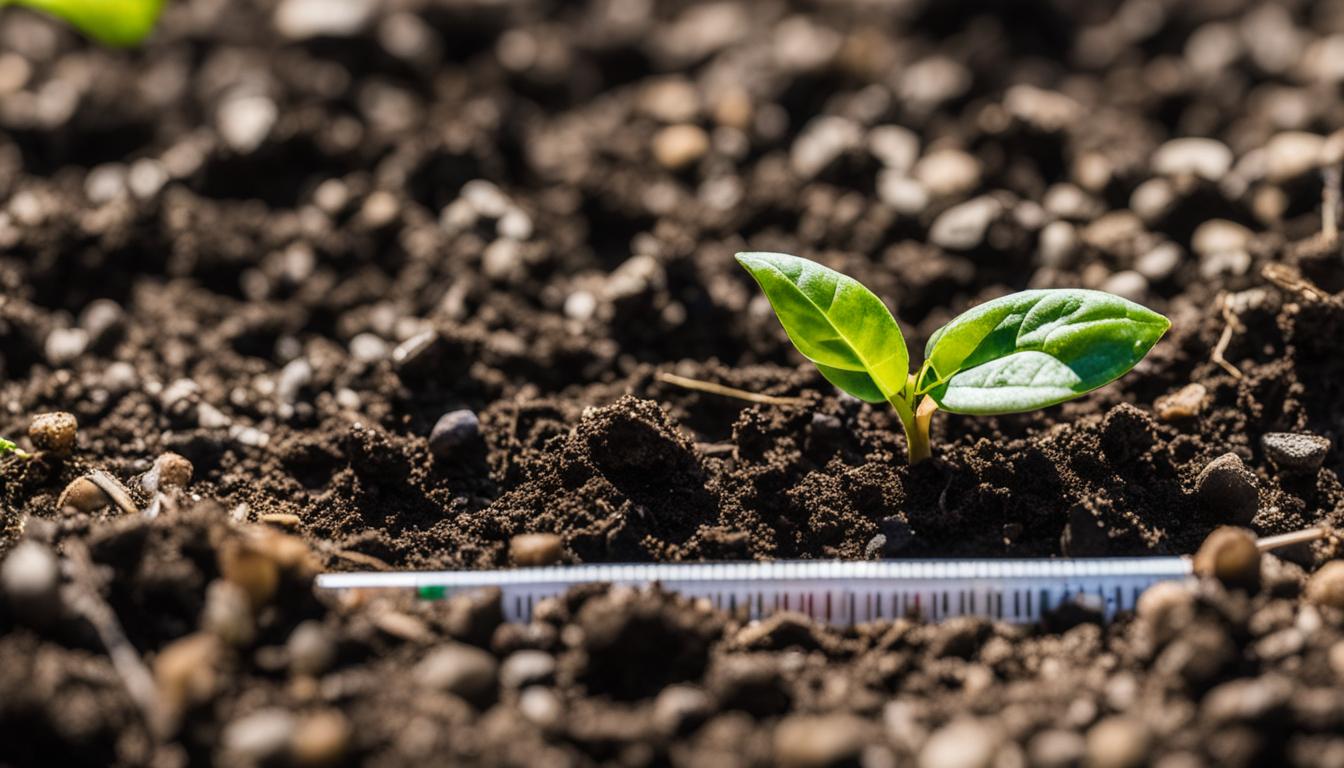
When it comes to successful gardening, timing is everything. Knowing the optimal planting times for your plants is crucial, and one important factor to consider is the soil temperature.
By using a soil thermometer, you can accurately measure the temperature of your soil and determine the best time to plant.
In this article, I will guide you through the process of using a soil thermometer and explain its significance in achieving optimal planting success.
Key Takeaways:
- Measuring soil temperature is essential for determining the right time to plant.
- A soil thermometer is a simple and effective tool for accurate temperature measurement.
- Take multiple readings at different times of the day to get an average temperature.
- Understanding the temperature requirements of specific plants is crucial for successful germination and growth.
- Proper soil preparation and weed control are also important factors for a successful vegetable garden.
The Importance of Soil Temperature for Planting
Soil temperature plays a crucial role in the germination and growth of plants. Different plants have different temperature requirements for successful germination.
It is essential to know the ideal soil temperature for the specific plants you want to grow to ensure proper growth and development. The temperature of the soil affects the availability of nutrients, microbial activity, and root development, all of which are vital for the overall health and productivity of plants.
Germination, the process by which a seed grows into a new plant, is directly influenced by soil temperature. Seeds require specific temperature ranges to break dormancy and initiate growth.
If the soil temperature is too low, seeds may take longer to germinate or fail to germinate altogether. Conversely, if the soil temperature is too high, it can inhibit germination and lead to poor seedling establishment.
By understanding the temperature requirements for germination, gardeners can optimize planting times and increase the success rate of their crops.
Furthermore, soil temperature affects the overall growth and development of plants. Plant roots function most efficiently within a certain temperature range.
If the soil is too cold, root growth may be restricted, leading to nutrient deficiencies and stunted plant growth. On the other hand, if the soil is too warm, root function can be impaired, reducing the plant’s ability to absorb water and nutrients.
Maintaining the appropriate soil temperature promotes healthy root development and enhances the plant’s ability to uptake and utilize essential resources.
Monitoring and maintaining the proper soil temperature is crucial for successful gardening. By using a soil thermometer, gardeners can accurately measure the temperature at various depths and times of the day.
This information can help determine the optimal planting times for different crops and ensure that plants are provided with the ideal conditions for growth.
Understanding the importance of soil temperature and its impact on plant development can significantly improve gardening outcomes and lead to more productive and thriving gardens.
Using a Soil Thermometer
Measuring the soil temperature is crucial for successful planting, and using a soil thermometer is a simple and effective way to achieve accurate results. By following a few easy steps, you can ensure that your plants are being planted at the right time.
- Insert the thermometer: Insert the soil thermometer into the ground at the recommended planting depth. Make sure it is positioned vertically for the most accurate reading.
- Allow time for measurement: Leave the soil thermometer in the ground for a few minutes, allowing it to adjust and provide an accurate temperature reading.
- Take multiple readings: To get a more accurate average temperature, take multiple readings at different times of the day. Soil temperature can vary depending on factors such as sunlight exposure, time of day, and weather conditions.
By using a soil thermometer and following these simple steps, you can make informed decisions about the optimal time to plant your seeds or seedlings. This will greatly increase the chances of successful germination and growth.
| Plant | Optimal Soil Temperature for Germination |
|---|---|
| Lettuce | 40°F or higher |
| Tomatoes | 70°F or higher |
| Carrots | 60°F or higher |
| Beans | 60°F or higher |
Table: Optimal soil temperatures for germination of select plants (source: First source)
Optimal Topsoil Temperature for Planting
When it comes to successful planting, understanding the optimal topsoil temperature is crucial. Different plants have specific temperature requirements for germination and growth, and meeting these requirements will ensure healthy and thriving plants in your garden. To help you achieve optimal results, here are the recommended topsoil temperatures for various types of plants:
| Plant Type | Topsoil Temperature (°F) |
|---|---|
| Forage Seeds | 45 or higher |
| Turf Grass and Row Crops | 50 to 55 |
| Warm-Weather Vegetables | 60 or higher |
For the successful germination of forage seeds, a topsoil temperature of 45 degrees or higher is required. Turf grass and row crops, such as corn and soybeans, thrive best when the topsoil temperature is in the range of 50 to 55 degrees.
When it comes to warm-weather vegetables like tomatoes, peppers, and cucumbers, the topsoil temperature should be 60 degrees or higher for successful germination. It’s important to note that these are general guidelines, and specific plants may have slightly different temperature requirements.
By ensuring that the topsoil temperature meets the requirements of the plants you are planting, you can provide them with the optimal conditions for growth and increase your chances of a successful harvest.
- Different plants have specific topsoil temperature requirements for germination and growth.
- Forage seeds require a topsoil temperature of 45 degrees or higher.
- Turf grass and row crops thrive best with a topsoil temperature of 50 to 55 degrees.
- Warm-weather vegetables require a topsoil temperature of 60 degrees or higher.
Regional Soil Temperatures
In order to make informed decisions about planting, it is crucial to understand the variations in soil temperatures by region. Soil temperatures can have a significant impact on the success of your garden, as different plants have different temperature requirements for germination and growth.
By familiarizing yourself with the soil temperature patterns in your area, you can ensure that you are planting at the optimal times.
Here is an overview of the general soil temperature ranges in different regions:
| Region | Average Soil Temperature Range |
|---|---|
| Southern United States | Average of 50 degrees or higher in February or March, reaching the low 60s by mid-April, and upper 70s to low 80s by mid-May |
| Midwestern United States | Average of 40 to 50 degrees in early spring, reaching the 60s by late spring |
| Northern United States | Average of 30 to 40 degrees in early spring, reaching the 50s by late spring |
| Western United States | Varies widely depending on specific location and elevation; coastal regions tend to have milder temperatures, while inland and mountainous regions can experience colder soil temperatures |
Keep in mind that these are general temperature ranges and can vary from year to year, so it is important to monitor the actual soil temperature in your specific garden and adjust your planting schedule accordingly.
Factors such as elevation, proximity to water bodies, and microclimates within your region can also influence soil temperatures.
By understanding the regional soil temperature variations, you can make informed decisions about when to plant your garden and ensure that your plants have the best chance of thriving.
The Role of Soil Temperature in Vegetable Planting
When it comes to planting vegetables, understanding the role of soil temperature is crucial for successful seed germination and growth. Different vegetables have specific temperature requirements, and planting at the optimal temperature can significantly improve your gardening outcomes.
Let’s take a closer look at the optimal planting temperatures for various vegetables:
| Vegetable | Optimal Planting Temperature |
|---|---|
| Lettuce, Kale, Peas, Spinach | 40 degrees or warmer |
| Onions, Leeks, Turnips, Swiss chard | 50 degrees or warmer |
| Broccoli, Cabbage, Cauliflower, Carrots, Beans | 60 degrees or warmer |
| Tomatoes, Squash, Corn, Cucumbers, Melons, Peppers | 70 degrees or warmer |
By understanding these temperature requirements, you can ensure that you plant your vegetables at the right time, setting them up for optimal germination and growth.
Monitoring the soil temperature with a reliable soil thermometer is an essential tool for any vegetable gardener.
Remember, the temperature of the soil can vary depending on the region and time of year. It’s important to be familiar with your local soil temperature patterns to make informed decisions about when to plant your vegetables.
Providing the ideal temperature for seed germination and growth will help you cultivate healthy and productive vegetable plants.
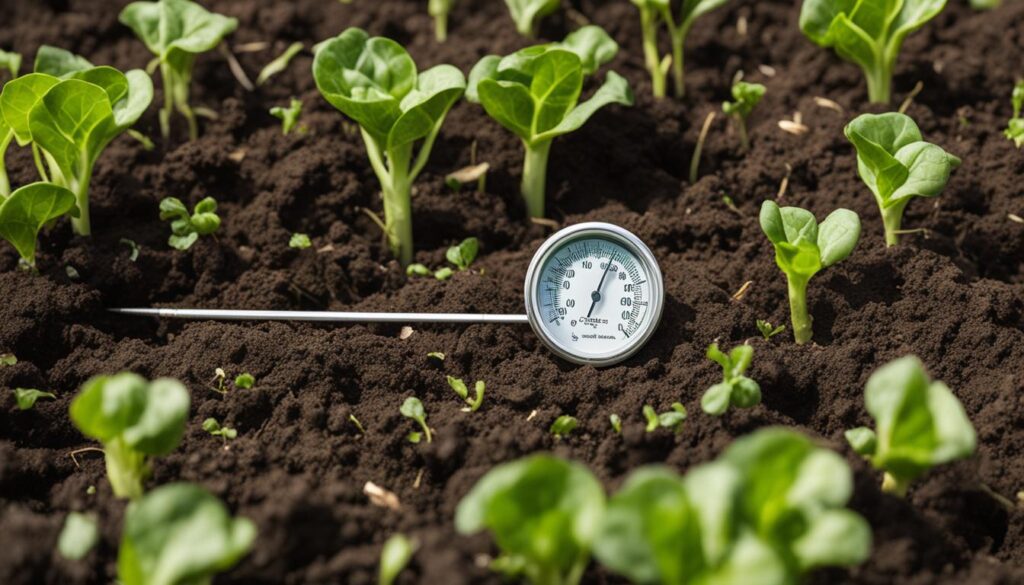
Understanding the role of soil temperature in vegetable planting is key to achieving successful outcomes in your garden.
By knowing the optimal planting temperatures for different vegetables and monitoring your local soil temperature, you can ensure that your plants have the best environment for germination and growth.
Using a soil thermometer will help you accurately measure and track the temperature, allowing you to make informed decisions about when to plant your vegetables.
Remember, each vegetable has its own temperature requirements, so it’s essential to tailor your planting schedule accordingly. By considering soil temperature, you can set the foundation for a thriving vegetable garden.
Tips for Using a Soil Thermometer
Accurate soil temperature measurement is crucial for successful planting. Here are some tips to help you effectively use a soil thermometer:
- Take measurements at the recommended planting depth: Insert the soil thermometer into the ground at the depth specified for the specific plant you are growing. This will provide you with the most accurate soil temperature reading.
- Make a pilot hole with a screwdriver: If the soil is compacted or hard, it may be challenging to insert the soil thermometer. To make it easier, create a pilot hole by gently pushing a screwdriver into the ground and then insert the thermometer into the hole.
- Allow a few minutes for the temperature to register: Once the soil thermometer is inserted, give it a few minutes to adjust and provide an accurate reading. This will ensure that you get the right temperature information.
- Provide shade for accurate readings: Direct sunlight can affect the accuracy of the soil temperature reading. To get the most precise measurement, place a small piece of cardboard or your hand above the soil thermometer to provide shade during the reading.
- Take multiple readings at different times of the day: Soil temperature can vary throughout the day due to sunlight exposure and other factors. To get a more comprehensive understanding of the soil temperature, take readings at different times, such as morning, midday, and evening. This will help you determine the average temperature.
By following these tips, you can ensure accurate soil temperature measurement and make informed decisions about the optimal time for planting your crops.
To use a soil thermometer effectively, take measurements at the recommended planting depth, create a pilot hole if necessary, allow time for the temperature to register, provide shade for accurate readings, and take multiple readings at different times of the day. These tips will help you obtain accurate soil temperature measurements and guide your planting decisions.
Soil Temperature and Planting Timing
Planting based on soil temperature is crucial for achieving optimal results in your garden. Understanding the relationship between soil temperature and planting timing can help you determine the best time to sow your seeds or transplant your seedlings.
By aligning your planting with the ideal soil temperature, you can provide your plants with the optimal conditions for growth and maximize their chances of success.
When it comes to cool-season crops, such as lettuce, kale, and peas, it is recommended to wait until the soil temperature reaches around 50 degrees Fahrenheit.
These crops thrive in cool weather and prefer the cooler soil temperatures of early spring or fall. On the other hand, warm-weather plants like tomatoes, squash, corn, and peppers require a soil temperature of 60 degrees Fahrenheit or higher.
Planting these crops too early, when the soil is still cold, can lead to stunted growth and other issues.
By paying attention to soil temperature and planting based on the specific requirements of your plants, you can ensure that they have the best possible start in your garden.
Monitoring soil temperature and adjusting your planting timing accordingly can make a significant difference in the success of your garden and the quality of your harvest.
Optimal Soil Temperatures for Common Vegetables
| Vegetable | Optimal Soil Temperature for Germination (Fahrenheit) |
|---|---|
| Lettuce, kale, peas, spinach | 40 or warmer |
| Onions, leeks, turnips, Swiss chard | 50 or warmer |
| Broccoli, cabbage, cauliflower, carrots, beans | 60 or warmer |
| Tomatoes, squash, corn, cucumbers, melons, peppers | 70 or warmer |
Table: Optimal soil temperatures for germination of common vegetables.
Protecting Plants from Cold Soil
When it comes to gardening, early planting can be tempting, but it’s important to protect your plants from the cold soil to ensure their healthy growth. Fortunately, there are several methods you can use to warm the soil and provide early planting protection.
1. Floating Row Covers
Floating row covers are a great option for protecting plants from cold soil. These lightweight, translucent fabrics act as a barrier, trapping heat from the sun and creating a warmer microclimate around your plants.
Simply drape the covers over your plants and secure them with stakes or weights. Remember to remove the covers during the day to allow sunlight and air circulation.
2. Individual Cloches
If you have smaller plants that need protection, individual cloches can be a practical solution. Cloches are transparent covers that can be placed over individual plants to create a mini greenhouse effect.
They help retain heat and protect your plants from cold winds. You can use cloches made of glass, plastic, or even repurposed containers like milk jugs or soda bottles with the bottoms cut off.
3. Mulching
Mulching is another effective method to warm the soil and protect your plants. Apply a layer of organic mulch, such as straw, wood chips, or shredded leaves, around your plants.
Mulch helps insulate the soil, preventing temperature fluctuations and reducing heat loss. It also helps suppress weed growth and retain soil moisture.
Remember, it’s essential to monitor the soil temperature and wait until it reaches the optimal range for the specific plants you are growing. Providing protection and using these methods to warm the soil can give your plants a head start and increase their chances of thriving in colder conditions.
Preparation Tips for a Successful Vegetable Garden
Proper preparation of the soil is essential for creating a thriving vegetable garden. By following these preparation tips, you can ensure that your garden has the right conditions for healthy plant growth.
Soil Preparation
The first step in preparing your vegetable garden is to assess the quality of your soil. Conduct a soil test to determine its pH level and nutrient content. This will help you identify if any amendments are needed.
If your soil is acidic, adding agricultural lime can help raise its pH level and create a more suitable environment for plant growth. On the other hand, if your soil is alkaline, adding sulfur or organic matter can help lower the pH level.
Soil Amendment
Once you have determined the pH level of your soil, it’s time to amend it with organic matter. Adding compost or well-rotted manure can improve the soil’s structure and nutrient content.
Spread a layer of compost or manure over the topsoil and work it into the ground using a garden fork or tiller. This will help loosen compacted soil and provide essential nutrients to your plants.
Weed Control
Weeds can compete with your vegetables for nutrients and water, so it’s important to establish effective weed control measures. Before planting, remove any existing weeds from the garden area.
Consider applying a layer of organic mulch, such as straw or wood chips, around your plants. This will help suppress weed growth and conserve moisture in the soil. Regularly monitoring your garden for new weed growth and manually removing them is also crucial.
| Preparation Tips for a Successful Vegetable Garden |
|---|
| Assess the soil quality and conduct a soil test to determine pH and nutrient levels. |
| Amend the soil with compost or well-rotted manure to improve its structure and nutrient content. |
| Remove existing weeds and apply organic mulch to suppress weed growth. |
By following these preparation tips, you can create an ideal environment for your vegetable garden. Remember to regularly monitor the soil moisture and adjust watering accordingly, and provide your plants with proper care and maintenance throughout the growing season.
Weed and Pest Control in Vegetable Gardens
Effective weed and pest control is crucial for maintaining the health and productivity of your vegetable garden. Weeds can compete with your vegetables for resources such as light, water, and nutrients, hindering their growth and development.
Pests like aphids, slugs, and caterpillars can cause significant damage to your plants if left unchecked. Therefore, taking proactive measures to monitor and control weeds and pests is essential.
When it comes to weed control, regular maintenance is key. Make it a habit to remove any existing weeds and prevent new ones from taking hold. Start by clearing the area of weeds before planting and continue to monitor the garden throughout the growing season.
Hand-pulling weeds is an effective method, but you can also use mulch to suppress weed growth and conserve moisture in the soil. Organic herbicides can be used as a last resort, but it’s important to follow the instructions carefully to avoid harming your vegetables.
As for pest control, early detection is crucial. Regularly check your plants for signs of pest activity and take appropriate action. Introduce beneficial insects like ladybugs and lacewings, which feed on common pests like aphids.
You can also use physical barriers such as row covers or netting to protect your plants from larger pests like birds and rodents. If necessary, organic insecticides can be used, but always follow the instructions and take precautions to minimize harm to beneficial insects and the environment.
Monitoring and Control of Insects and Pests
Implementing a monitoring and control strategy is essential for effectively managing insects and pests in your vegetable garden. Keep a close eye on your plants and regularly inspect them for any signs of pest damage.
Look for chewed leaves, wilting, discoloration, or the presence of insects. Early detection allows for early intervention, preventing further damage and the spread of pests.
When it comes to control methods, it’s important to choose options that are safe for you, your plants, and the environment. Integrated pest management (IPM) is a holistic approach that combines various strategies to manage pests effectively.
This can include cultural controls (such as crop rotation and companion planting), biological controls (such as introducing beneficial insects), and mechanical controls (such as handpicking pests and using traps).
Remember, maintaining a healthy ecosystem in your garden is key to preventing and managing pests. Encouraging biodiversity and providing habitat for beneficial insects can help keep pest populations in check naturally.
By employing a combination of monitoring, prevention, and control strategies, you can keep your vegetable garden free from weeds and pests, ensuring the success of your crops.
Additional Resources for Vegetable Gardening
If you’re looking for more information and guidance on vegetable gardening, there are several additional resources available to help you plan and maintain your garden effectively.
One valuable resource is the extension publications, such as “Growing Your Own,” which provide comprehensive planting schedules and guidelines tailored to different regions.
These publications offer insights into the ideal planting times, recommended spacing, and tips for managing a successful vegetable garden.
Alongside extension publications, you can also find informative guides on vegetable gardening. These guides typically cover a wide range of topics, including soil preparation, seed starting, transplanting, watering, and pest management. They provide step-by-step instructions and expert advice to support you throughout your gardening journey.
Online forums and communities dedicated to vegetable gardening are another great resource. These platforms allow gardeners to share their experiences, ask questions, and receive recommendations from fellow enthusiasts.
Participating in these communities can provide valuable insights and enable you to connect with a network of knowledgeable gardeners.
Remember, the key to successful vegetable gardening is continuous learning and experimentation. By utilizing additional resources, you can stay informed, expand your knowledge, and improve your gardening skills over time.
FAQ
How do I use a soil thermometer to determine optimal planting times?
To use a soil thermometer, simply insert it into the ground at the recommended planting depth and wait a few minutes for an accurate reading. Take multiple readings at different times of the day to get an average temperature.
Why is soil temperature important for planting?
Different plants have different temperature requirements for successful germination. Knowing the ideal soil temperature for the specific plants you want to grow is crucial for proper growth and development.
How can I measure soil temperature?
You can measure soil temperature by using a soil thermometer. Insert the thermometer into the ground at the recommended planting depth and allow it to sit for a few minutes to get an accurate reading.
What is the optimal topsoil temperature for planting?
Most forage seeds require a topsoil temperature of 45 degrees or higher to germinate. Turf grass and row crops need a topsoil temperature in the range of 50 to 55 degrees. It’s important to ensure the soil temperature meets the requirements of the specific plants you are planting.
How do regional soil temperatures vary?
Soil temperatures vary by region and time of the year. In the southern United States, soil temperatures typically reach an average of 50 degrees or higher in February or March. By mid-April, soil temperatures can reach the low 60s, and by mid-May, temperatures can climb to the upper 70s to low 80s.
What is the role of soil temperature in vegetable planting?
Different vegetables have different temperature requirements for successful seed germination. Lettuce, kale, peas, and spinach require a soil temperature of 40 degrees or warmer, while tomatoes, squash, corn, cucumbers, melons, and peppers require a temperature of 70 degrees or warmer.
What are some tips for using a soil thermometer?
Some tips for using a soil thermometer include taking measurements at the recommended planting depth, making a pilot hole with a screwdriver for easier insertion, providing shade for accurate readings, and taking multiple readings at different times of the day to get an average temperature.
How does soil temperature affect planting timing?
Planting based on soil temperature can significantly improve the success of your garden. Cool-season crops should be planted when the soil temperature is around 50 degrees, while warm-weather plants require a soil temperature of 60 degrees or more.
How can I protect plants from cold soil?
If you can’t resist the urge to plant when the soil is still cold, you can protect your plants by using floating row covers, individual cloches, or makeshift covers like milk jugs or soda bottles. These methods provide insulation and help warm the soil.
What are some preparation tips for a successful vegetable garden?
Proper preparation of the soil is crucial for a successful vegetable garden. Adding compost, balanced fertilizer, and agricultural lime to the soil can improve its nutrient content and structure. Clearing the area of weeds and incorporating the amendments into the soil will create an ideal environment for plants to thrive.
How can I control weeds and pests in my vegetable garden?
Regular weeding is essential, especially in the first few weeks after planting. Monitoring and controlling pests, such as slugs and aphids, is also important to protect your plants from damage. Addressing weed and pest issues early on will ensure the health and productivity of your vegetable garden.
Where can I find additional resources for vegetable gardening?
Extension publications such as “Growing Your Own” provide comprehensive planting schedules and guidelines for different regions. These resources can help you determine the ideal planting times and spacing for various vegetables, as well as provide tips for managing a successful vegetable garden.

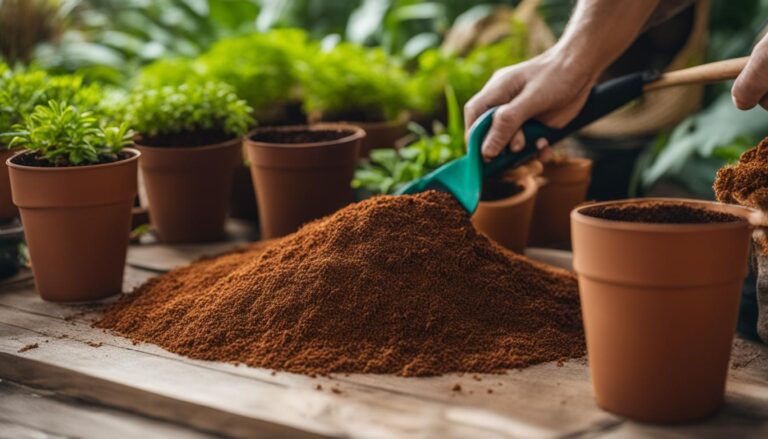
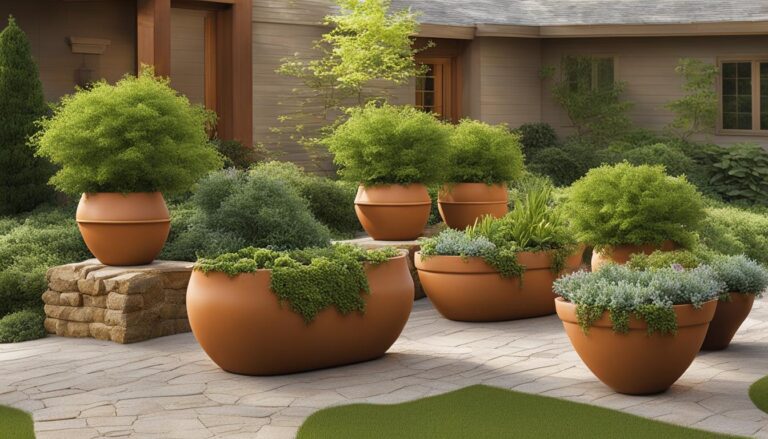

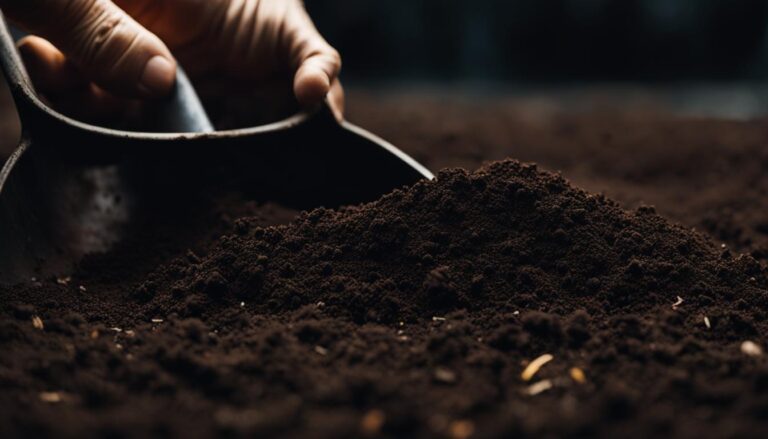
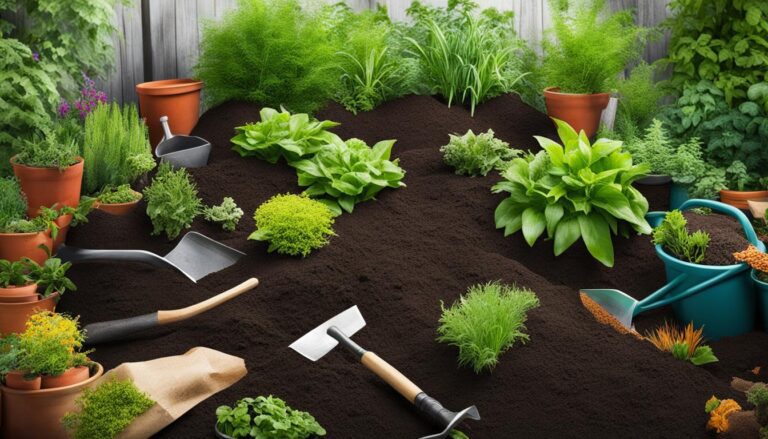
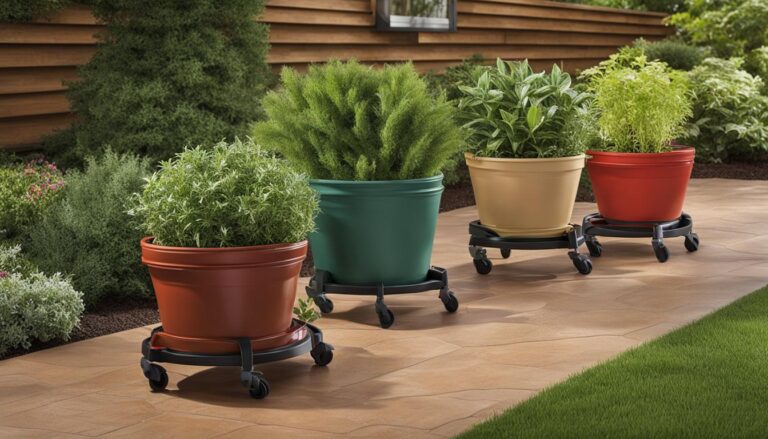
2 Comments
Comments are closed.